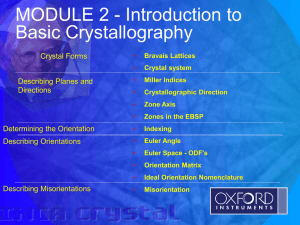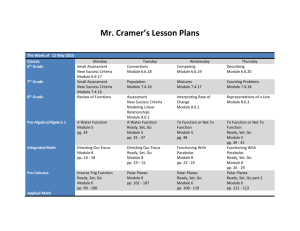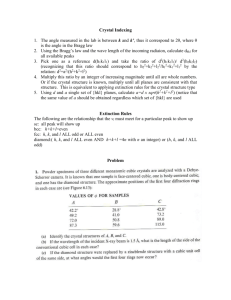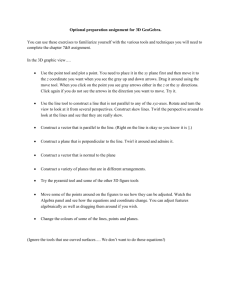Crystallographic Directions, and Planes
advertisement
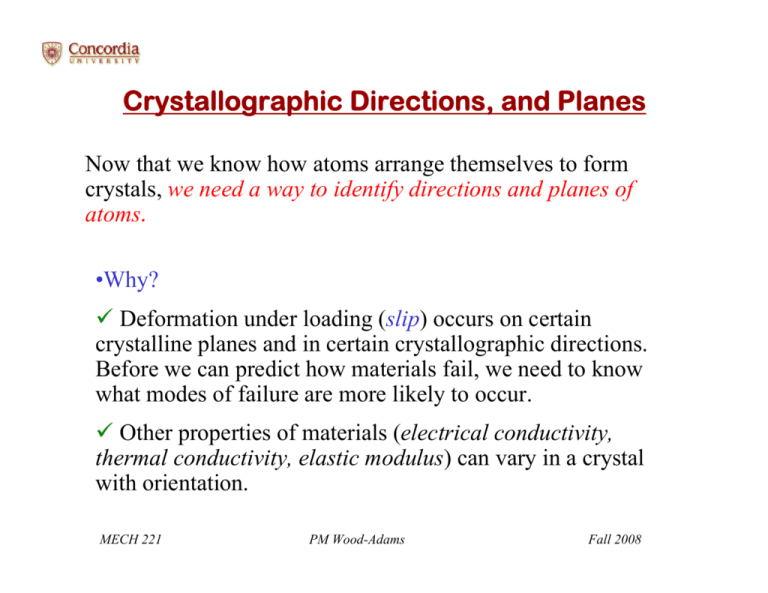
Crystallographic Directions, and Planes
Now that we know how atoms arrange themselves to form
crystals, we need a way to identify directions and planes of
atoms.
•Why?
9 Deformation under loading (slip) occurs on certain
crystalline planes and in certain crystallographic directions.
Before we can predict how materials fail, we need to know
what modes of failure are more likely to occur.
9 Other properties of materials (electrical conductivity,
thermal conductivity, elastic modulus) can vary in a crystal
with orientation.
MECH 221
PM Wood-Adams
Fall 2008
Crystallographic Planes & Directions
direction
plane
• It is often necessary to be able to specify certain directions
and planes in crystals.
• Many material properties and processes vary with direction
in the crystal.
• Directions and planes are described using three integers Miller Indices
MECH 221
PM Wood-Adams
Fall 2008
Point coordinates
• Point position specified in terms of its coordinates as
fractional multiples of the unit cell edge lengths
Z
111
000
0 .5 0
Y
X
MECH 221
PM Wood-Adams
Fall 2008
Example
Find the Miller indices for the points in the cubic unit cell
below:
I
J
K
Note: J is on the left face of the cube, H is on the right face,
K is on the front face and I is on the back face
MECH 221
PM Wood-Adams
Fall 2008
General Rules for Lattice Directions,
Planes & Miller Indices
•
•
•
•
Miller indices used to express lattice planes and directions
x, y, z are the axes (on arbitrarily positioned origin)
a, b, c are lattice parameters (length of unit cell along a side)
h, k, l are the Miller indices for planes and directions expressed as planes: (hkl) and directions: [hkl]
• Conventions for naming
– There are NO COMMAS between numbers
– Negative values are expressed
with a bar over the number
• Example: -2 is expressed 2
MECH 221
PM Wood-Adams
• Crystallographic direction:
– [123]
– [100]
– … etc.
Fall 2008
Miller Indices for Directions
Method
– Draw vector, and find the coordinates
of the head, h1,k1,l1 and the tail
[???]
h2,k2,l2.
z
[111]
– subtract coordinates of tail
from coordinates of head
y
– Remove fractions by
multiplying by smallest
possible factor
– Enclose in square brackets
[100]
[110]
x
– What is ???
MECH 221
PM Wood-Adams
Fall 2008
Example - Naming Directions
MECH 221
PM Wood-Adams
Fall 2008
Families of Directions
• Equivalence of directions
[101] ≠ [110]
[101] = [110]
tetragonal
cubic
•
<123> Family of directions
¾ [123], [213], [312], [132], [231], [321]
– only in a cubic crystal
In the cubic system directions having the same indices
regardless of order or sign are equivalent.
MECH 221
PM Wood-Adams
Fall 2008
Miller Indices for Planes
• (hkl) Crystallographic plane
• {hkl} Family of crystallographic planes
– e.g. (hkl), (lhk), (hlk) … etc.
In the cubic system planes having the same indices
regardless of order or sign are equivalent
• Hexagonal crystals can be expressed in a four
index system (u v t w)
– Can be converted to a three index system using
formulas
MECH 221
PM Wood-Adams
Fall 2008
Miller Indices for PLANES
z
Method
• If the plane passes through the
origin, select an equivalent plane
or move the origin
• Determine the intersection of the
plane with the axes in terms of a,
b, and c
• Take the reciprocal (1/∞ = 0)
• Convert to smallest integers
x
(optional)
Intercepts
• Enclose by parentheses
Reciprocals
(111)
y
x
y
z
1
1
1
1
1
1
see example 3.8
MECH 221
PM Wood-Adams
Fall 2008
Crystallographic Planes
z
z
(011)
(001)
y
y
x
x
z
z
(212)
(201)
y
y
x
x
MECH 221
Green circles
show where the
origins have
been placed.
PM Wood-Adams
Fall 2008
Planes and their negatives are
equivalent
z
(0 1 0)
(010)
y
x
MECH 221
PM Wood-Adams
Fall 2008
In the cubic system, a plane and a
direction with the same indices are
orthogonal
z
y
x
MECH 221
PM Wood-Adams
Fall 2008
Linear and Planar density
• Linear Density
– Number of atoms per length whose centers lie on the
direction vector for a specific crystallographic direction.
# of atoms centered on a direction vector
LD =
length of direction vector
• Planar Density
– Number of atoms per unit area that are centered on a
particular crystallographic plane.
# of atoms centered on a plane
PD =
area of plane
MECH 221
PM Wood-Adams
Fall 2008
Example
• Find the linear density of the [110] and the
[100] direction in the FCC cell in terms of
the atomic radius R
[100]
[110]
MECH 221
PM Wood-Adams
Fall 2008
Linear and Planar Density
• Why do we care?
– Properties, in general, depend on linear and planar
density.
• Examples:
Speed of sound along directions
– Slip (deformation in metals) depends on linear and
planar density
– Slip occurs on planes that have the greatest density of
atoms in direction with highest density (we would say
along closest packed directions on the closest packed
planes)
MECH 221
PM Wood-Adams
Fall 2008



